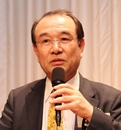Modern Kampo Medicine for Rotarians
April 25, 2012
Mr. Keiji Nishimoto
Chairman & Chief Executive Officer, Shinjuku Kaijo Bldg. Clinic
 I have engaged myself in Kampo medicine, providing diagnoses at the Department of Geriatrics and Vascular Medicine, Tokyo Medical and Dental University, as well as Shinjuku Kaijo Building Clinic. Kampo can be narrowly defined as a ��traditional crude drug hot liquid therapy, which developed uniquely in Japan originating in the ancient Chinese medicine.�� Its broader interpretation includes acupuncture, moxibustion, massage and dietary treatment.
I have engaged myself in Kampo medicine, providing diagnoses at the Department of Geriatrics and Vascular Medicine, Tokyo Medical and Dental University, as well as Shinjuku Kaijo Building Clinic. Kampo can be narrowly defined as a ��traditional crude drug hot liquid therapy, which developed uniquely in Japan originating in the ancient Chinese medicine.�� Its broader interpretation includes acupuncture, moxibustion, massage and dietary treatment.
Western medicine was introduced to Japan between mid- to late Edo era and was named Ranpo (Dutch medicine) to differentiate from our traditional Kampo. Oriental medicine can include wider-ranging areas of the Middle East and India, yet my speech today will center on the three traditional medicines of East Asia, which are namely Japan, South Korea and China. All three originate from the ancient Chinese medicine, yet they have different names. Cyui refers to traditional medicine of China today, while Kampo��refers to that of Japan and Kan��i to that of South Korea. While these three traditional medicines share some common theoretical concepts, there are various schools that follow different practices.
I do not adhere to the traditional Kampo medicine only. My goal is to provide the best medical treatment, thus I take a flexible stand and support the so-called ��modern Kampo�� which incorporates the advantages of both modern Western medicine and traditional Oriental medicine. Kampo medicine can complement what might be lacking in Western medicine to bring greater effect.
Western medicine is highly resourceful. Its superior diagnostic imaging utilizes CT, MRI or echo. Its blood test also gives thousands of results. What makes Western medicine different from Kampo? In short, Western medicine is analytical, while Kampo��is holistic. Western medicine takes an approach of quantification and objectivization, while Kampo is based on experience and intuition.
In old days, patients were considered sick from head to toe. By the early 18th century, Western medicine regarded a disease to be the sickness of a specific organ, thus took a new approach of organ pathology. The German pathologist Rudolf Virchow published ��Cellular Pathology�� in 1858 and proved that diseases were caused at cellular level, which form the basis of Western medicine today.
Kampo, on the other hand, focused on a patient��s clinical condition. Its basic principle is to remedy the pathological imbalance of a healthy body towards a well-balanced condition. For example, Kampo cools down the heated part, warms up the chill, discharge the excess, supplements the insufficient and circulates the stagnant.
Crude drug of Kampo might sound something special, yet there are many plant-based modern drugs, such as aspirin made from willow bark, ephedrine from ephedra, digitalis from foxglove, vincristine from periwinkle, morphine from poppy sap, and penicillin from penicillium. Widespread outbreak of influenza became a big issue quite recently and the antiviral drug ��Tamiflu�� aroused much craze. This drug was originally made from the Chinese spice ��star anise�� widely used for cooking. Please note that the Kampo medicine ��Maoutou�� is as effective as Tamiflu, which has no side effects for children and thus is safe and reliable.
Now let me show you how to brew the Kampo crude drugs. We prescribe several or even a dozen kinds of drugs, which are prepared into single-dose small packages at dispensing pharmacies. You must rip open the package and mix the drug with tap water (amount of 600-1,000 milliliters). The standard boiling time is 40 minutes. Earthen pots were used in older days, but we now have ��decoction pot with microcomputer�� that prevents the water from boiling over.
Dr. Kanehiro Takaki, the founder of Jikei University School of Medicine, left the words ��See the patients without seeing only their diseases.�� I believe his motto shares the common spirit with Rotary activities. I cherish his words, especially because Dr. Takaki and I both come from Miyazaki Prefecture.
Now, let me inform you about some specific Kampo drugs and ways of their administration, depending on specified symptoms.
1. Norovirus infection
Norovirus triggers diarrhea, especially during the winter after eating raw fish or clams. Hange-shashin-tō [14] is effective. Mix 2 packages with 100-milliliter warm water and take it orally. Afterwards, take 1 package every several hours. Combining Shinbu-tō [30] can be more effective.
2. Stomatitis
Hange-shashin-tō [14] is also effective for stomatitis. Mix one package with little water and put the paste to the ulcer. Disturbing pain will disappear in 3 minutes.
3. Globus pharyngeus
Female patients largely outnumber, suffering from persistent sensation of having some obstruction in the throat when there is nothing. Hange-kōboku-tō [16] is effective.
4. Excessive drinking and hangover
Ōren-gedoku-tō is effective. Take 1 package when you leave the bar, take another package during the night. And if you take the third package in the morning before you leave for work, your condition will get perfect. Capsules of Ōren-gedoku-tō are good for headaches and sickness caused by hangover. Gorei-san [17] is good for gastrointestinal discomfort by excessive drinking.
5. Cold chill and sore throat
You can get rid of early symptoms of a cold by drinking Maō-bushi-saishin-tō [127], which is also available as capsules. I recommend the elderly to store it in their home medicine chest.
6. Disturbing and painful leg cramp
Taking Shakuyaku-kanzō-tō [68] before going to bed is effective.
7. Alopecia areata
Taking Rokumi-gan [87] along with Keishi-bukuryō-gan can be effective.
8. Severe atopic dermatitis
Jūzen-daiho-tō [48] has possibilities to be effective for severe atopic dermatitis.